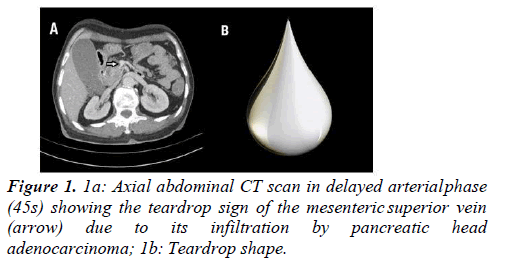Image Article - Archives of General Internal Medicine (2021) Volume 5, Issue 5
The teardrop sign of Superior Mesenteric Vein (SMV).
Kaoutar Imrani* , Sanae Amalik, Hounayda Jerguigue, Rachida Latib, Youssef Omor
1Department of Radiology, Oncology National Institute, Rabat, Morocco
- Corresponding Author:
- Dr. Imrani Kaoutar
Department of Radiology, Oncology National Institute, Rabat, Morocco
E-mail: drben654@gmail.com
Accepted date: 11 May, 2021
Citation: Imrani K.The teardrop sign of Superior Mesenteric Vein(SMV). Arch Gen Intern Med 2021;5(5):10-10.
Description
Pancreatic head adenocarcinoma is a cancer with a poor prognosis, usually discovered lately. The CT scan with contrast enhancement at the delayed arterial phase (45s) plays an important role in assessment of vascular extension by evaluating the invasion of the celiac trunk, the superior mesenteric and hepatic arteries, the Superior Mesenteric Vein (SMV) and the portal vein. The teardrop sign describes the invasion of the superior mesenteric vein by pancreatic head adenocarcinoma. The SMV takes the shape of a teardrop with a rounded and a pointed end (Figure 1). Surgical excision is the only curative treatment for pancreatic adenocarcinoma. The tumor is unresectable if there is metastasis, arterial contact greater than 180°C or non-reconstructable venous extension (SMV and portal vein). The difficulties associated with PHAC include higher frequencies of regional or distant lymph node metastases and vascular involvement, and positive resection margins in pancreatic and retroperitoneal tissues. Radical resections increase margin negativity and life expectancy; however, the extend of the surgery applied is controversial. Thus, western and eastern centers may use different approaches. Multiorgan, peripancreatic nerve plexus, and vascular resections have been discussed in relation to radical surgery for pancreatic cancer as have the roles of neoadjuvant and adjuvant therapy regimens. Determining the appropriate limits for surgery, standardizing definitions and surgical techniques according to guidelines, and centralizing pancreatic surgery within high-volume institutions to reduce mortality and morbidity rates are among the most important issues to consider. The challenges associated with Pancreatic Head Adenocarcinoma (PHAC) include higher frequencies of regional or distant Lymph Node (LN) metastases and positive resection margins in the pancreatic and retroperitoneal tissues. Several routes drain lymph from the pancreatic head, and the three main lymphatic drainage pathways are a superior pathway that drains lymph into the celiac and two inferior pathways that drain lymph into the LNs around the SMA (Figure 1) [1,2].
References
- Hough TJ, Raptopoulos V, Siewert B, et al. Teardrop superior mesenteric vein: CT sign forss unresectable carcinoma of the pancreas. Am J Roentgenol. 1999;173:1509-12.
- Ahmed MZ, Chrisopher LW, Matthew JW, et al. Multidetector CT: Different classification systems and their influence on treatment planning. Radiographics. 2017;37:93-112.
